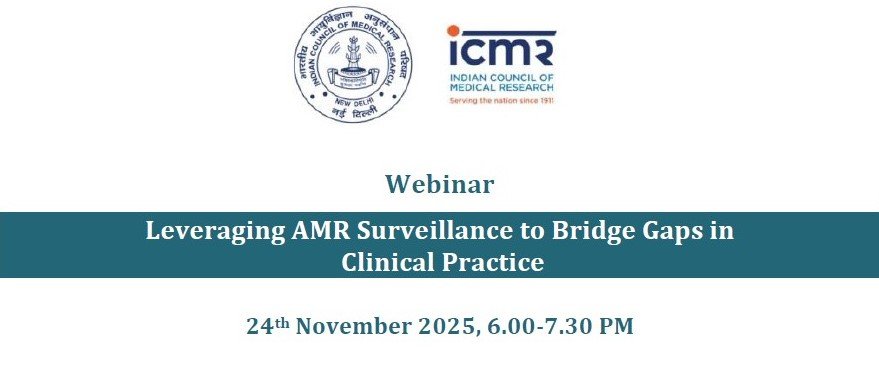This post is for academic purposes only. Please read the original guidelines if you intend to use the guideline for clinical purposes.
The National Guidelines for Infection Prevention and Control (IPC) in Healthcare Facilities (HCFs) in India were published by the Ministry of Health and Family Welfare in January 2020. It addresses various aspects of IPC, including the rising threat of antimicrobial resistance (AMR), standard precautions, specific infection control practices, and surveillance of healthcare-associated infections (HAIs). The guidelines are intended to standardise practices across healthcare settings and are informed by various national and international bodies such as ICMR, National Health Mission, WHO, and CDC.
Key Themes and Concepts:
The Urgency of Addressing Antimicrobial Resistance (AMR):
- The document highlights the significant and growing threat of AMR, referencing the emergence of New Delhi metallo-β-lactamase (NDM) )-producing bacteria.
- It provides alarming statistics, showing increases in resistance to commonly used antibiotics like cephalosporins, fluoroquinolones, and carbapenems in E. coli and Klebsiella pneumoniae. For instance, “From 2008 to 2013, Escherichia coli resistance to third-generation cephalosporins increased from 70% to 83%, and resistance to fluoroquinolones increased from 78% to 85%.”
- This underscores the need for robust IPC measures to curb the spread of resistant organisms.
The Importance of IPC for Accreditation and Surveillance:
- The guidelines emphasize the role of IPC standards in the accreditation of HCFs by the National Accreditation Board for Hospitals and Healthcare Providers (NABH).
- Surveillance for HAIs is recognised as a critical component, although currently limited to NABH-accredited hospitals. There is a stated goal to expand this.
- The document acknowledges the establishment of an HAI surveillance network by AIIMS and ICMR, aiming to standardise data collection and analysis with their software, which should help “track HAIs”.
Understanding Colonization vs. Infection:
- The document clearly differentiates between colonization and infection, explaining that “Colonization refers to the presence of organisms in the body without causing any cellular damage…Infection occurs when the organism causes cellular damage and a host response.”
- It explains how normal flora can cause infection in another site, “Colonizing organisms can be a part of the normal flora for a particular body site but cause infection at another body site, for example, E. coli is a normal flora of the intestinal tract, but it can cause infection in the urinary tract.”
- This distinction is essential for implementing targeted preventive measures.
Common Healthcare-Associated Infections (HAIs) and their Risk Factors:
- The guidelines identify common HAIs such as Urinary Tract Infections (UTIs), Surgical Site Infections (SSIs), and gastrointestinal infections.
- For UTIs, the document highlights organisms like E. coli, Klebsiella spp., and Enterococci spp. and risk factors such as indwelling catheters and poor aseptic techniques.
- SSIs are associated with organisms such as Staph. aureus and E. coli and risk factors, including high BMI, diabetes, and prolonged surgery.
- Gastrointestinal infections are associated with organisms like Salmonella spp., Shigella spp., and Clostridium difficile, and risk factors such as extremes of age, antibiotic use, and invasive procedures.
Role of Key Personnel in IPC:
- The document emphasises the collaborative nature of IPC, assigning specific responsibilities to various professionals.
- The microbiologist is essential for the identification of causative agents and providing guidance on antimicrobial treatment.
- Hospital pharmacists are responsible for the procurement and dispensing of antiseptics, disinfectants, and antibiotics and play a role in antimicrobial stewardship.
Risk Assessment and Risk Management (RA-RM) for IPC:
- The document emphasizes the importance of assessing the frequency and magnitude of potential hazards in order to prioritise measures.
- It recommends using scales (e.g. 3 or 5-point scales) to quantify the risks and plan action accordingly. For example, “Imminent and catastrophic: something needs to be done immediately; Rare and mild: a strategic long-term plan needs to be in place”.
- An example of a RA-RM table for a district hospital/medical college is included, addressing issues such as a lack of IPC systems, fire risks, inadequate laboratory support, and insufficient PPE supply.
Hand Hygiene:
- Hand hygiene is presented as a critical measure. The guidelines state, “WASH HANDS WHEN VISIBLY SOILED! OTHERWISE, USE HANDRUB.”
- The document specifies situations where hand hygiene is necessary (before and after patient contact, after touching body fluids, after removing gloves, etc).
- Both handwashing with soap and water and the use of alcohol-based hand rubs (ABHR) are recommended.
Glove Use:
- The guidelines clearly define indications for the use of sterile and non-sterile (examination) gloves, including invasive procedures, potential contact with blood/body fluids, and epidemic situations.
- They stress that gloves should not be washed or reused between patients and that hand hygiene should be performed after removing gloves.
- A “glove pyramid” is referenced to indicate where gloves are indicated vs not.
Injection Safety
- The guidelines stipulate that injections should be prepared in a designated clean area, cleaned with 70% alcohol.
- Single-use needles and syringes are required.
- Multi-dose vials must be discarded if sterility is compromised or if past the date limit (e.g. 28 days after opening).
- The importance of aseptic technique when preparing and administering injections is highlighted.
- It includes a list of “don’ts” for injection safety, such as not reusing syringes or needles and avoiding contamination of injection vial diaphragms.
Environmental Control and Disinfection:
- The document covers the use of disinfectants, particularly sodium hypochlorite. A detailed table is provided showing dilutions for 0.5%, 1% and 2% solutions based on bleach concentration.
- The importance of a clean water supply is emphasised.
- Specific methods for cleaning water tanks, fixtures, and surfaces are outlined.
- The guidelines give requirements for food handling and storage, especially for immunocompromised patients.
Surgical Asepsis:
- Guidance is provided on surgical hand preparation, including the removal of jewellery, nail cleaning, and the use of antimicrobial soaps or ABHR.
- The concept of a sterile field is described, emphasising the need to keep sterile items and personnel separate from non-sterile ones.
- Recommendations are given for the use of maximal sterile barrier precautions during invasive procedures, such as central line insertion.
Catheter Care:
- Recommendations are included for the prevention of Catheter-Associated Urinary Tract Infections (CAUTI), including verifying the need for insertion, using an aseptic technique, and proper maintenance. A bundle of care is provided for insertion.
- Specific guidance is provided on urinary catheter management and catheter care.
- Best practices for the prevention of Central Line-Associated Bloodstream Infections (CLABSI) are included, e.g. using sterile equipment and an aseptic technique for maintenance. A bundle of care for insertion is included.
Infection Control in Special Units:
- The document addresses the unique challenges of IPC in units like haemodialysis units, blood banks, and laboratories.
- It stresses the need for water purification in dialysis, the safe reprocessing of dialysers, and the importance of monitoring dialysate.
- Laboratory safety is addressed with a focus on practices, personal protective equipment (PPE), and facility design based on risk level using biosafety levels (BSL 1-4).
Healthcare-Associated Infection (HAI) Surveillance:
- The guidelines discuss the need for HAI surveillance using standardized methods and definitions.
- It includes the calculation of SSI rates, UTI rates, and CAUTI rates. It includes formulae.
- It includes a sample line list for an outbreak in a paediatric ICU.
- It also details surveillance periods for SSIs following NHSN surgical procedures.
- The document also identifies patients with multidrug-resistant organisms (MDRO) and specifies that contact precautions should be initiated.
Biomedical Waste Management:
- The guidelines include a detailed annexe on biomedical waste management based on BMW rules, 2016 and 2018.
- It outlines colour coded waste categories: yellow, red, white and blue, and suitable treatment/disposal options for each.
- It includes specific guidance on incinerator usage and emission standards for biomedical waste.
- It includes information on standards for autoclaving, microwaving and dry heat sterilization.
Key Quotes:
- *”Rising trends of AMR are a major concern…New Delhi metallobetalactamase (NDM) producing bacteria first reported in 2008, are now found worldwide.
- “Colonization refers to the presence of organisms in the body without causing any cellular damage…Infection occurs when the organism causes cellular damage and a host response.”
- “WASH HANDS WHEN VISIBLY SOILED! OTHERWISE, USE HANDRUB”
- “The date of discard from the opening of a multi-dose vial should be decided by the HICC of the facility. Normally, it is 28 days from the date of opening, even if it is within the expiry date.”
- “Maximal sterile barrier precautions shall be used, regardless of whether the placement takes place in the OT or ward.”
Conclusion:
The “National Guidelines for IPC in HCF” provides a comprehensive framework for infection prevention and control in Indian healthcare facilities. It emphasizes the need to tackle AMR, improve hygiene practices, establish robust surveillance systems, and ensure compliance with standardised procedures. The guidelines provide practical, detailed instructions and information across all aspects of infection prevention, as well as relevant tables and references. They are designed to promote patient safety and reduce the burden of HAIs. Its success depends on the collaboration and commitment of healthcare professionals across all levels.
Quiz
- What is the difference between colonisation and infection?
- Name three common organisms that cause urinary tract infections (UTIs).
- What is the role of the microbiologist in the IPC program?
- What does RA-RM stand for in the context of IPC?
- When should alcohol-based hand rub (ABHR) be used instead of hand washing with soap and water?
- Give three examples of when sterile gloves are indicated.
- What is the recommended timeframe for discarding a multi-dose medication vial after opening?
- Why is reverse osmosis used in haemodialysis?
- What is the importance of using a biological indicator during autoclave operation?
- How is the SSI rate calculated?








